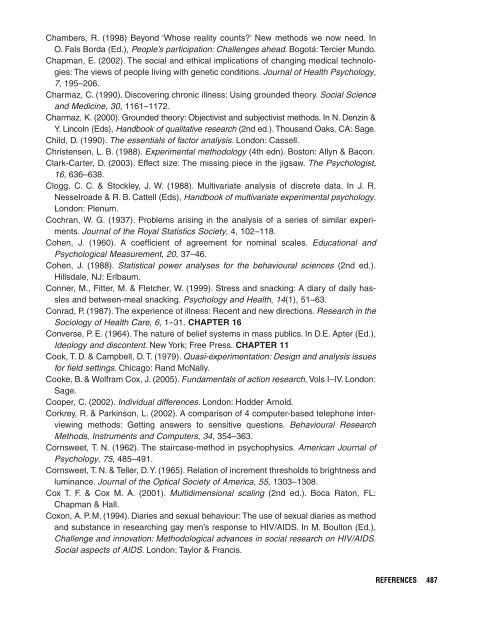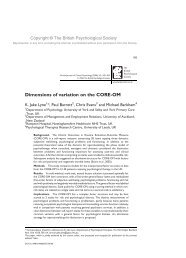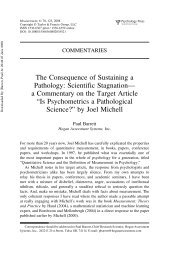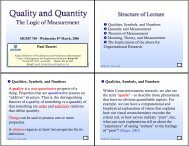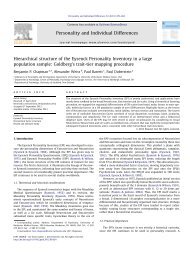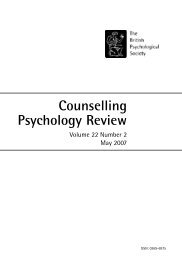Psychophysiological Methods - Paul Barrett
Psychophysiological Methods - Paul Barrett
Psychophysiological Methods - Paul Barrett
- No tags were found...
Create successful ePaper yourself
Turn your PDF publications into a flip-book with our unique Google optimized e-Paper software.
Breakwell-3389-Reference.qxd 2/7/2006 9:03 PM Page 487Chambers, R. (1998) Beyond ‘Whose reality counts?’ New methods we now need. InO. Fals Borda (Ed.), People’s participation: Challenges ahead. Bogotá: Tercier Mundo.Chapman, E. (2002). The social and ethical implications of changing medical technologies:The views of people living with genetic conditions. Journal of Health Psychology,7, 195–206.Charmaz, C. (1990). Discovering chronic illness: Using grounded theory. Social Scienceand Medicine, 30, 1161–1172.Charmaz, K. (2000). Grounded theory: Objectivist and subjectivist methods. In N. Denzin &Y. Lincoln (Eds), Handbook of qualitative research (2nd ed.). Thousand Oaks, CA: Sage.Child, D. (1990). The essentials of factor analysis. London: Cassell.Christensen, L. B. (1988). Experimental methodology (4th edn). Boston: Allyn & Bacon.Clark-Carter, D. (2003). Effect size: The missing piece in the jigsaw. The Psychologist,16, 636–638.Clogg, C. C. & Stockley, J. W. (1988). Multivariate analysis of discrete data. In J. R.Nesselroade & R. B. Cattell (Eds), Handbook of multivariate experimental psychology.London: Plenum.Cochran, W. G. (1937). Problems arising in the analysis of a series of similar experiments.Journal of the Royal Statistics Society, 4, 102–118.Cohen, J. (1960). A coefficient of agreement for nominal scales. Educational andPsychological Measurement, 20, 37–46.Cohen, J. (1988). Statistical power analyses for the behavioural sciences (2nd ed.).Hillsdale, NJ: Erlbaum.Conner, M., Fitter, M. & Fletcher, W. (1999). Stress and snacking: A diary of daily hasslesand between-meal snacking. Psychology and Health, 14(1), 51–63.Conrad, P. (1987). The experience of illness: Recent and new directions. Research in theSociology of Health Care, 6, 1–31. CHAPTER 16Converse, P. E. (1964). The nature of belief systems in mass publics. In D.E. Apter (Ed.),Ideology and discontent. New York; Free Press. CHAPTER 11Cook, T. D. & Campbell, D. T. (1979). Quasi-experimentation: Design and analysis issuesfor field settings. Chicago: Rand McNally.Cooke, B. & Wolfram Cox, J. (2005). Fundamentals of action research, Vols I–IV. London:Sage.Cooper, C. (2002). Individual differences. London: Hodder Arnold.Corkrey, R. & Parkinson, L. (2002). A comparison of 4 computer-based telephone interviewingmethods: Getting answers to sensitive questions. Behavioural Research<strong>Methods</strong>, Instruments and Computers, 34, 354–363.Cornsweet, T. N. (1962). The staircase-method in psychophysics. American Journal ofPsychology, 75, 485–491.Cornsweet, T. N. & Teller, D.Y. (1965). Relation of increment thresholds to brightness andluminance. Journal of the Optical Society of America, 55, 1303–1308.Cox T. F. & Cox M. A. (2001). Multidimensional scaling (2nd ed.). Boca Raton, FL:Chapman & Hall.Coxon, A. P. M. (1994). Diaries and sexual behaviour: The use of sexual diaries as methodand substance in researching gay men’s response to HIV/AIDS. In M. Boulton (Ed.),Challenge and innovation: Methodological advances in social research on HIV/AIDS.Social aspects of AIDS. London: Taylor & Francis.REFERENCES487


